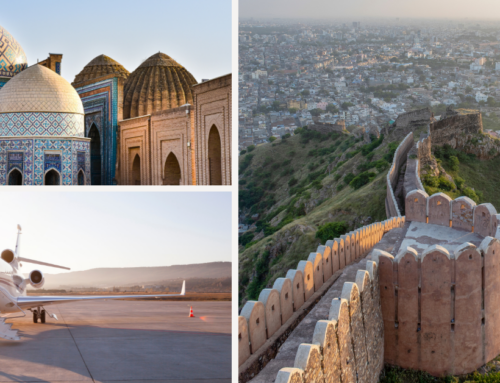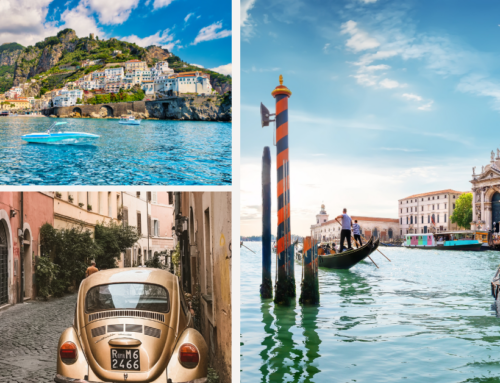Greece is at the top of the bucket list for many travelers around the world. Known as much for its architectural feats as the culinary delights, friendly locals, and spectacular beaches, it welcomes millions of tourists each year. In addition, Greece is considered the birthplace of civilization and entices visitors to step back in time and peer at the lives and stories of the extraordinary people who inhabited these lands thousands of years ago. From dazzling temples to strikingly preserved theatres to iconic monuments, we have compiled a list of the top 12 fascinating ancient sights in Greece.
There is no question that Greece is a jaw-droppingly beautiful country. However, what makes it among the most enchanting places in the world goes beyond the charming whitewashed villages and azure waters splashing up on the craggy shores of ancient volcanic islands. The country is a goldmine for literature, history, and art aficionados. If you’re looking to explore this fascinating culture in more depth, you will not be disappointed.
1. Acropolis of Athens

Classic spirituality, traces of Greek antiquity, diverse culture, and impressive architecture make up modern Athens. While the city embraces the twenty-first century, it keeps a firm hold on the past. Exploring Athens means stepping inside the birthplace of philosophy, democracy, and art – the home of Plato, Aeschylus, Socrates, Euripides, and Sophocles. The Acropolis citadel is perched high on top of a rocky outcrop, on a hill overlooking the city. It is undoubtedly Athen’s crown jewel.
The Acropolis is remarkably well-preserved and home to many structures, including the Parthenon, Temple of Athena Nike, Propylaea, and Erechtheion. Over the centuries, the Acropolis held many roles. It was the home of the Mycenaean kings, a fortress, a mystical home of the gods, a political center, and finally, a tourist attraction. On the west side of the Acropolis, you’ll find marbled steps which pave the way to the most famous building in Athens, the Parthenon. This magnificent temple was dedicated to the Greek goddess of Athena. Do not miss the opportunity to explore the exceptional Acropolis Museum.
2. Ancient Delphi

Visitors who venture around 100 miles from Athens through Cyprus forests and tranquil olive groves will find themselves at yet another UNESCO World Heritage Site: Ancient Delphi. The city lies on the slopes of Mount Parnassus, above the Gulf of Corinth, and is certainly one of the most fascinating ancient sights in Greece. Delphi was the sanctuary for Apollo, the God of light and music, and the shrine of his oracle, the Priestess Pythia. The oracle was said to enter a dream-like trance and divine the future, providing cryptic predictions and guidance from Apollo himself.
Take a walk along The Sacred Way, the main route through the Sanctuary of Apollo, leading from the gateway uphill to the Temple of Apollo. This was the site where the oracle delivered her prophecies. Sadly, all that remains of the Temple of Apollo, the most important building in the sanctuary today, is the foundation. Still, visitors can use their imagination to reconstruct how it once looked. Also, make sure to spend some time in the Theater, built in the fourth century BC to accommodate over 5,000 spectators.
Ancient Greeks considered Delphi the center of the world, the Omphalos – the “navel of the Earth.” An ancient marble monument discovered during excavation, the Omphalos, marks the spot the Greek’s considered the world’s navel. The original stone is on display at the museum of Delphi while a replica remains on site.
3. Acropolis and Old Town Rhodes

The Acropolis of Rhodes is another stunning Hellenistic sanctuary in what was once the city of Rhodes on Rhodes Island. It dates back to 408 BC, and today the site is a contrast between ancient wonders and modern life. It contains temples, monuments, and public buildings. Unfortunately, the temple’s excavation is incomplete and represents a mere fragment of the Acropolis’ original grandeur. However, we encourage you to use your imagination and picture how this city once appeared. First, take a stroll around the partially reconstructed Temple of Pythion Apollo, which stands at the summit, and enjoy the breathtaking panoramic views. Sadly, the Temple of Apollo suffered substantial bomb damage during World War Two and underwent restoration work in the 1960s and 1970s. Then explore the Odeion, Stadium, Temple of Athena Polias and Zeus Polieus, library, and the Nymphaia.
A few miles away, a double set of soaring walls separate the UNESCO-listed, medieval Old Town from the modern city. Stroll the Street of the Knights and explore the Archaeological Museum (Hospital of the Knights) and Palace of The Grand Masters. The Knights of St. John constructed the Palace in the 1300s, but it fell into despair after their departure. However, Italians rebuilt the Palace of The Grand Masters in the 1930s, first as a holiday home for King Emmanuel III and later used by Italy’s infamous dictator, Mussolini. After exploring the castle, walk along the ramparts of the old town walls, built by the Byzantines and reinforced by the knights. The walls serve as a fine example of medieval fortifications.
4. Minoan Palace of Knossos, Crete

The Minoan Palace of Knossos in Crete unravels the mystery of Minoan civilization. Explore Crete’s most expansive archaeological site and wander through the multi-story structures. Ceremonial rooms, treasuries, throne rooms, and vast halls decorate the palace, but you’ll be more thrilled to see the Throne room of Knossos, which preserves some of its original colors.
Knossos also has a unique connection with Greek mythology. According to legend, the mythical King Minos, son of Zeus and Europa, resided in the palace. King Minos instructed Daedalus to construct a labyrinth to keep his son, the Minotaur, a mythical creature, half-bull and half-man.
5. Ancient Theatre of Epidaurus

The Ancient Theatre of Epidaurus was built in the 4th century and is widely considered the most beautiful and well-preserved theatre of its kind. Used by both Romans and Greeks, the theatre holds awe-inspiring history and sordid legends.
Visitors are mesmerized by the sheer size of the space, which accommodates around 13,000 spectators. At the same time, the incredible quality of the theatre’s acoustics perplexed researchers for decades. When standing at the base of the theatre, the ‘altar,’ the slightest noise is carried perfectly throughout the theatre. Thus, it is easy to imagine the thrilling performances held in this space over the centuries. Luckily, this theatre still frequently has events today, including the annual Epidaurus Festival.
6. Ancient Olympia

Oh, Greece, the place of endless archaeological treasures! Ancient Olympia gave birth to the legendary Olympic Games. The most famous sporting event in the ancient world symbolized honor, integrity, and, of course, competition. The Olympic Games took place here every four years from 776 BC to 393 AD. Step into the stadium, and you can almost hear the roar of the crowds.
However, Olympia was not simply a sporting destination, used every four years. Residents also created remarkable works of art and culture dedicated to the Greek God Zeus. As a result, the temple of Zeus gained importance for travelers and citizens alike.
You can still catch a glimpse of the glory days in Ancient Olympia; impressive sculptures and statues of Hermes of Praxiteles, Nike of Painois, and of course, Zeus proudly showcase their history. Inside the enclosed court/Peribolos of the Atlis, you can see shrines of gods.
If you’re looking to explore more than just the archaeological site, head to the Archaeological Museum of Olympia to gaze at various historical artifacts and priceless antiques that once decorated the sanctuary.
We suggest visiting during spring, preferably April to October, because the galleries are open daily and for longer times. To see Olympia genuinely come alive with music and culture, attend the Ancient Olympia Festival or the Olympia International Film Festival for Children and Young People. The Ancient Olympia festival lasts from July to August, while the International Film Festival takes place in December.
7. Ancient City of Kamiros, Rhodes

On the northwestern coast of the island of Rhodes, visitors find ruins of the ancient city of Kamiros. Once nestled among fig trees, vineyards, and olive groves, Kamiros bequeathed a rich culture to Rhodes. Although it is often compared to Pompeii, Kamiros was not destroyed by natural disasters. Instead, it fell into a gradual decline due to abandonment. Residents left the city to pursue opportunities in the new city of Rhodes.
Visiting Kamiros is an enlightening experience. Wander the Temple of Athena, stroll along Main Street, explore the Archaic Cistern, and enjoy a few peaceful moments in Fountain Square. Further along from the Sanctuary of Athena, you’ll find the remnants of old graves whose accidental uncovering led to the sanctuary’s discovery.
8. Meteora

The Meteora clifftop Monasteries are a UNESCO World Heritage site, serving as a place of worship and reflection for over a thousand years. Historically, the monasteries were used by Orthodox-Christian hermit monks who chose this landmark for its isolation and spiritual essence. Each year, thousands of tourists make their way to Meteora to experience the calm and peaceful ambiance and marvel at the ancient structures precariously perched on enormous rock pillars.
In all, Meteora is home to six holy monasteries: the Monastery of St. Nikolas, Holy Trinity, St. Stephen, Roussanou, Varlaam, and the Great Meteoron. These monasteries served as the homes of ancient monks and visiting artists, philosophers, and writers who preserved Hellenic culture during the Turkish occupation. At night, lights from the town of Kalambaka illuminate the cliffs of Meteora, giving an ethereal appearance.
9. Mycenae

Add Mycenae to your list of brilliant archaeological sites and mythological cities. According to Greek myths, Perseus, son of the Greek God Zeus, founded Mycenae. When Perseus left Argos, he instructed Cyclopes, the one-eyed giants, to build walls around the city with stones no human could lift or destroy. You may also know that Homer’s epics sang many praises to Mycenae, the kingdom of Agamemnon in the Iliad, during the Trojan war. Once a thriving city, today Mycenae displays reconstructions of the palaces dated to 1350 BC. Unfortunately, after a prosperous period, the city fell into decline. Residents eventually abandoned Mycenae completely.
The treasures of Mycenae remained hidden for centuries. Excavations conducted in the twentieth century recognized the site for its richness and grandeur. Visitors find the small museum of Mycenae engaging and uniquely rich in history. Stone walls and a clear pathway guide visitors to the glorious tomb of Agamemnon adorned with relics of the mighty ancient civilization.
10. Nafplion Fortress of Palamidi

Greece truly does quench your thirst for knowledge. While many visitors focus their attention on famous sites from ancient Greek civilization, there are many incredible remnants from medieval times, the Renaissance, and beyond worthy of exploration. The city of Nafplion is a melting pot of cultural influences dating back thousands of years.
One of the best examples of Venetian influence is the Fortress of Nafplion, otherwise known as the Palamidi Fortress. It is genuinely a Venitian architectural masterpiece. This fortress is far more preserved than many others on this list, mainly because it was erected in the early eighteenth century.
Before ascending to the fort, notice the eye-catching bastions, eight in total, each mightily secured to prevent any breach. The central stronghold is the grandest of all. Inside the fortifications, the relics of its occupants are still visible today. An interesting historical fact is that the citadel once served as a prison. Nine hundred ninety-nine steps lead up to the fort. The poor souls confined to the jail built the steps as one form of physical labor punishment for their crimes. This certainly qualifies Palamidi Fortress as one of the most fascinating ancient sights in Greece.
Before departing, make sure to take a few hours and explore Nafplio’s Old Town. Complete with its neoclassical houses, flowering balconies, storybook streets, castles, fortresses, and colorful Turkish fountains, the city is a mind-boggling historical cornucopia.
11. Minoan Akrotiri

Not far from the whitewashed villages, breathtaking caldera views, and luxury resorts on Santorini island lies the Ancient city of Minoan Akrotiri. It played a significant role in early civilization. Formerly connected to influential trade countries in the Middle East, Minoan Akrotiri was known for its flourishing economy and culture. Four thousand years before Mount Vesuvius buried Pompeii, the colossal volcano Thera erupted on Santorini. This eruption was one of the greatest volcanic events ever recorded on Earth. It created a four-mile-wide caldera and buried Akrotiri under 200-feet of ash and debris.
Stroll through the remains of multistoried buildings, and marvel at the architecture, glimpsing inside the life of an ancient civilization. Allow yourself to get lost in the beauty of this city and let your imagination take you back thousands of years.
The ruins are located on the island’s south side, an easy trip from Oia or Fira. Buses run regularly from Fira to Akrotiri, but we recommend hiring a private guide to make the most of your time and understand the true significance of the site. On a hot day nearby, Red Beach offers a great respite from the afternoon sun.
12. The Temple of Olympian Zeus, Athens

How could we talk about Greek attractions and not mention the Temple of Olympian Zeus in Athens? Built over several centuries to honor the Greek God, work started in 174 BCE and was completed over 600 years later. The temple was indeed an arresting sight in its heyday, with 104 exceptionally tall, hand-carved columns. It was the most fantastic ornament of the new eastern suburb of Athens. The colossal size and ambitious layout made the Temple of Olympian Zeus one of the grandest ever constructed in the ancient world. Sadly an earthquake destroyed most of the temples during the Middle Ages. However, the 15 remaining columns offer a glimpse of the original grandeur.
While we listed our top 12 fascinating ancient sights in Greece, there are undoubtedly thousands more worth visiting. Greece is a country steeped in a rich heritage, tradition, and history and one you will want to return to time and again.
Boutique Travel Advisors is a full-service, luxury travel agency. We specialize in creating bespoke itineraries for discerning clients around the world. Please visit our website or call 480-787-1477 to speak with a dedicated travel expert.
Are you planning an international or domestic trip? Check out our other articles to help you come prepared!
We highly recommend the purchase of travel insurance to protect your financial investment and health while traveling internationally. To purchase a policy with our preferred travel insurance company Arch RoamRight click here.
If you would like assistance purchasing a travel insurance policy, please get in touch with a BTA advisor.
https://travelbta.com/greek-islands-off-the-beaten-path-and-crowd-free/
https://travelbta.com/your-luxury-travel-essentials-made-simple/








